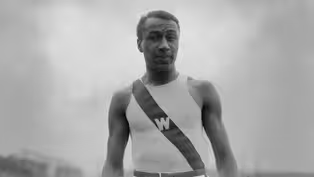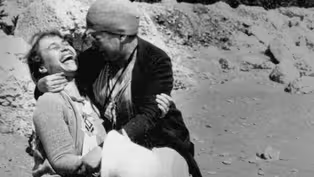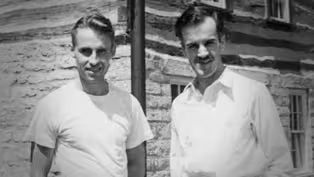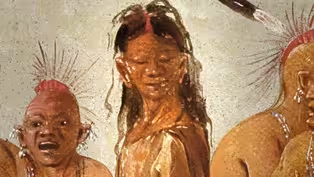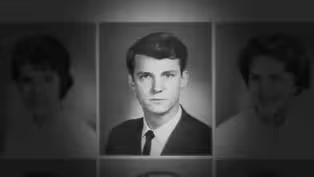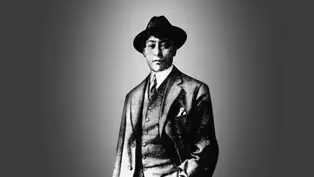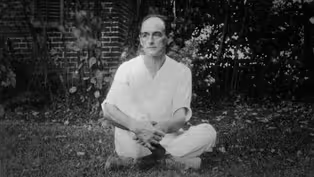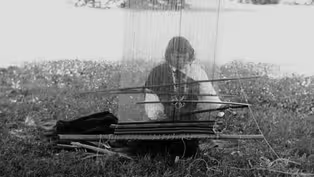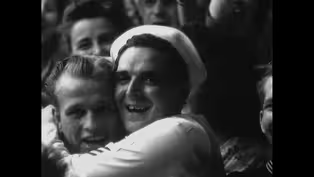Wisconsin Pride
Haresfoot
Clip: Special | 6m 35sVideo has Closed Captions
In UW’s Haresfoot club, men performed in drag, but members ran afoul of the University.
In 1948, the Haresfoot theatrical group was celebrating its 50th year of staging original musicals on the UW-Madison campus. The shows featured men playing all the women’s roles, setting gender norms and expectations. But gay members of the troupe were targeted for removal by the University after a raid on an off-campus party. The “Haresfoot Problem” led to years of homophobic policies at UW.
Problems playing video? | Closed Captioning Feedback
Problems playing video? | Closed Captioning Feedback
Wisconsin Pride is a local public television program presented by PBS Wisconsin
Funding for Wisconsin Pride is provided by Park Bank, SC Johnson, the Greater Milwaukee Foundation, the Evjue Foundation, the charitable arm of the Capital Times, TruStage, the New Harvest Foundation,...
Wisconsin Pride
Haresfoot
Clip: Special | 6m 35sVideo has Closed Captions
In 1948, the Haresfoot theatrical group was celebrating its 50th year of staging original musicals on the UW-Madison campus. The shows featured men playing all the women’s roles, setting gender norms and expectations. But gay members of the troupe were targeted for removal by the University after a raid on an off-campus party. The “Haresfoot Problem” led to years of homophobic policies at UW.
Problems playing video? | Closed Captioning Feedback
How to Watch Wisconsin Pride
Wisconsin Pride is available to stream on pbs.org and the free PBS App, available on iPhone, Apple TV, Android TV, Android smartphones, Amazon Fire TV, Amazon Fire Tablet, Roku, Samsung Smart TV, and Vizio.
[propellers rotating] - Lieutenant Kenneth Palmer from Edgerton, Wisconsin, was a decorated war hero, surviving over 50 dangerous missions, including a harrowing bombing run over Munich.
As he navigated his B-24 bomber over his target, the plane took on heavy anti-aircraft fire.
A piece of flak ripped through the nose of his plane, sending shrapnel flying toward Palmer.
His jacket took the brunt, shredding into pieces.
But the young navigator miraculously walked away with little more than a few bruises and a story for the ages.
He quipped, "If they can come that close and not get me, I'm safe."
[bell ringing] After the war, Kenneth Palmer returned to college at the University of Wisconsin-Madison.
He and so many of his fellow veterans were looking to catch up on the years and opportunities lost to the war.
Palmer studied commerce and served as secretary and also performer in the extracurricular theater troupe, the Haresfoot Club.
[applause] [band plays rousing music] - Scott Seyforth: Haresfoot was a theatrical organization that formed on campus in the late 1890s.
- Singers: ♪ Have you ever been to a picture show?
No!
♪ - Scott Seyforth: And they were very popular at the time.
They would perform six, seven, eight sold-out shows.
And they would get on the train, and they would do a tour.
They thought it was good publicity for the University, but they didn't like the idea of sending men and women out together on the road.
It turned into one of these all-male companies where men played the women's roles.
- Haresfoot Cast: ♪ Follow the girls ♪ ♪ [inaudible] ♪ ♪ Follow the girls ♪ - The Haresfoot motto became "All our girls are men, yet everyone's a lady."
- Scott Seyforth: They'd go to Eau Claire and La Crosse, sometimes to St. Paul, and do their shows.
[men singing] It was the Wisconsin Idea in drag.
[applause] - Dick Wagner: Though the company was predominantly heterosexual, there were a lot of gay men who were attracted to Haresfoot.
- The theater was a sanctuary.
- Dick Wagner: You have both sexuality and gender identity all mixed up together.
- The element of drag allowed performers to experiment with gender roles publicly.
To be expressive about sexuality under the protection of theatrical satire.
- Dick Wagner: Haresfoot was willing to push those boundaries.
- In 1948, the Haresfoot Club was ce lebrating its 50th anniversary with an original show, Big as Life, a send-up of th e legendary Paul Bunyan myth.
The cast included senior Kenneth Palmer, donning a red wig to portray the female role of Mabel.
The group's 50th year would be a fateful one.
- Scott Seyforth: A University police officer found two men making out in a car on campus, and he arrested them.
In their car was an invitation to a party at a private home.
- Police raided the Adams Street house party and made arrests on morals and sodomy charges.
- Scott Seyforth: Two of the men involved in that sting operation were members of Haresfoot.
- Kenneth Palmer was arrested, his name and address printed in the newspaper.
The press called the home "a den for lewd activities."
- Dick Wagner: On campus, there was concern about this growing outbreak of homosexuality.
And so, there was an investigation launched of the Haresfoot theater troupe.
- The investigative committee called upon psychiatrist Dr. Annette Washburne for guidance.
- Scott Seyforth: Dr. Washburne had a classification of homosexuals.
She believed that there were 'pseudo homosexuals' that could be treated.
'True homosexuals' were a danger on campus, and she really believed that the University needed to get rid of those people.
- Kenneth Palmer completed hi s requirements for graduation.
But at the highest levels of the University, his degree was denied.
- Scott Seyforth: There's a belief that to graduate gay men into society is a stain on the University.
It's appalling.
It's regrettable.
It's unfathomable.
- In 1950, Cold War tensions were brewing in Korea.
War hero Kenneth Palmer anticipated a return to service.
He pleaded with the University to have his degree granted, emphasizing that it would be unlikely for him to rise through the officer ranks without a diploma.
Once again, he was denied.
- Fallout from the Haresfoot Scandal would not end with Palmer.
A silent force would push the next generation of gay students deeper into hiding.
Video has Closed Captions
Clip: Special | 7m 25s | La Crosse’s George Poage, the first Black Olympic medalist, lived a hidden life. (7m 25s)
Video has Closed Captions
Clip: Special | 6m 13s | The progressive, visionary lesbian couple behind Milwaukee's Institute of Art and Design. (6m 13s)
Video has Closed Captions
Clip: Special | 6m 56s | Influenced by Warner’s example, two gay men created the influential historic site. (6m 56s)
Preview: Special | 3m | George Poage, forced to hide his LGBTQ+ identity, became the first Black Olympic medalist. (3m)
Preview: Indigenous Two-Spirit
Preview: Special | 3m 35s | Wisconsin's LGBTQ+ history and present includes Indigenous two-spirit people. (3m 35s)
Video has Closed Captions
Clip: Special | 6m 11s | A secret policy of removing gay students and staff from UW-Madison took an enormous toll. (6m 11s)
Video has Closed Captions
Clip: Special | 5m 44s | Put on trial for gender expression, Ralph Kerwineo became the “Girl-Man” of Milwaukee. (5m 44s)
Video has Closed Captions
Clip: Special | 4m 17s | Called Wisconsin’s first out gay man, Warner defied the gender expectations of his time. (4m 17s)
Video has Closed Captions
Clip: Special | 3m 42s | Two-Spirit is a term today encompassing many Indigenous beliefs about gender identity. (3m 42s)
Video has Closed Captions
Clip: Special | 2m 6s | World War Two fight held unfulfilled promises for a better life for LGBTQ+ Americans. (2m 6s)
Providing Support for PBS.org
Learn Moreabout PBS online sponsorshipSupport for PBS provided by:
Wisconsin Pride is a local public television program presented by PBS Wisconsin
Funding for Wisconsin Pride is provided by Park Bank, SC Johnson, the Greater Milwaukee Foundation, the Evjue Foundation, the charitable arm of the Capital Times, TruStage, the New Harvest Foundation,...
